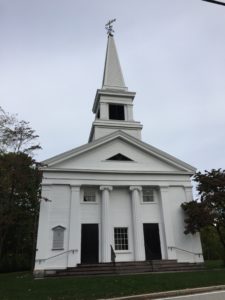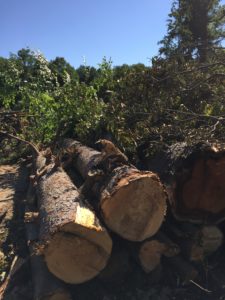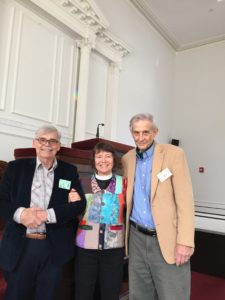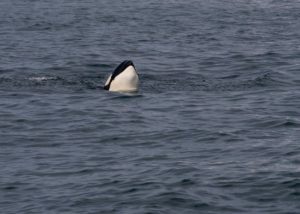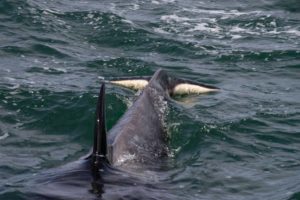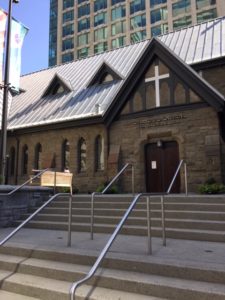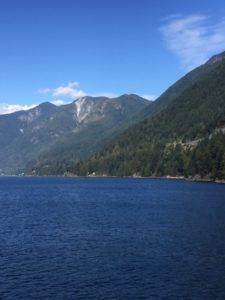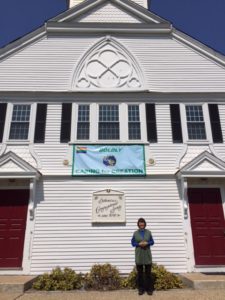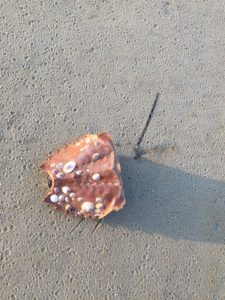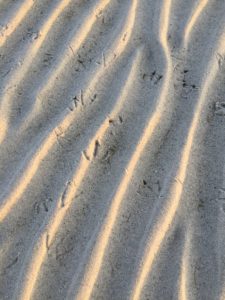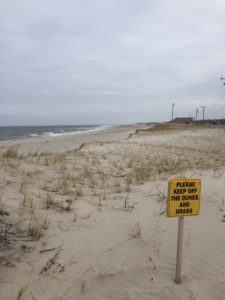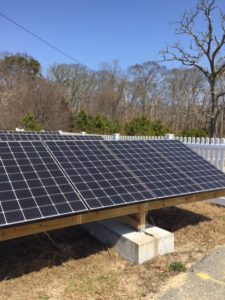Faith-based environmental activism can take many forms. Your event could be small: a handful of people gather one evening outside a church, holding candles and praying for upcoming U.N. climate negotiations. Or your event could be large: hundreds of people share a multi-faith worship service at which they sing, preach, and pray about caring for Earth.
Your event could be simple: a panel of speakers from different faith traditions discusses the spiritual foundations of environmental activism. Or your event could be complex, with multiple components: maybe an interfaith crowd will gather to sing, speak, and pray on the steps of your State House, hold a procession inside, carry out more speaking and singing at your Governor’s office, and then spread out for an afternoon of lobbying. Your event could be even more ambitious than that: it could, for instance, launch with an interfaith service and continue with a pilgrimage across your state, pausing as you hold educational events along the way and sleep on the floor of houses of worship; it might conclude with a large, interfaith service indoors, followed by a public rally outdoors.
Your faith-based event could be legal or it could include non-violent civil disobedience. It could be a stand-alone action or it could weave itself into something larger, such as the 10,000 people of faith who marched together in the People’s Climate March in 2014, joining a river of hundreds of thousands of people who coursed through the streets of New York City.
Whatever form it takes, your event will require planning. Here comes a list of thirteen steps for carrying out an effective and memorable faith-based environmental action. Please add your own suggestions at the bottom of this post!
1. Gather and tend the seeds
Someone has the seed of a brilliant idea (“Let’s carry out civil disobedience on Good Friday to stop new pipelines in our city.” “Let’s walk across the state to raise awareness of climate change.” “Let’s honor the sacredness of water by paddling downriver, praying all the way.”). Welcome your seeds of inspiration. Gather a group of friends, test and refine your ideas, generate more ideas, and see who has time and energy to join a planning team.
2. Only connect
Who else needs to be included in designing and carrying out the event? How wide a circle do you want to cast? Who are your potential allies? This part of the process may take a good deal of time, thought, and relationship building.
You will need to decide if you want to create an event for people of just one faith tradition, for people of several faith traditions, or for people of all faith traditions. Because so many folks no longer identify with a particular religious tradition, considering themselves “spiritual but not religious,” you may decide to promote your event as being “for all people of faith and good will.”
You will need to decide if you want the event to be led by clergy and other recognized religious leaders, and, if so, if you want those leaders to be locally known and grown or to have a wider following.
You will need to decide if, and to what degree, “your” event is open to being shaped and led by other stakeholders. For example, if you are middle-class and white, are you open to meeting with people of color and to low-income and immigrant communities as you muse on a potential action? Will you listen to their needs and hopes? How will they be included as participants and leaders? Again, if you are middle-aged and older, how will you engage youth as participants and leaders? If you are part of a “mainstream” religion, will you reach out to indigenous religious leaders? How will you take into account the needs of the differently abled, such as those who are deaf or hard of hearing, or those who need an accessible walkway?
Creating an interfaith environmental event provides a precious opportunity to build relationships across boundaries of age, race, and class, and to respect “intersectionality,” that big mouthful of a word that acknowledges that different forms of oppression (such as race, class, and gender) overlap and intersect. As Naomi Klein has said, to change everything we need everyone.
3. Go for ‘now’ time and ‘deep’ time
An event that honors “now” time is an event that is timely. Will you hold your event during the final push to pass important legislation? Will your event try to affect an upcoming election? Will it be held on the eve of an important national or international event, such as Pope Francis’ visit to the U.S. or the next round of U.N. climate talks? Will it be held in the aftermath of an environmental disaster, such as an oil spill, hurricane, or wildfire?
A timely event will also explore the possibility of aligning with the larger climate movement. Can your prayer vigil, procession, pilgrimage, worship service or rally be timed to coincide with other events being carried out around the world? Right now the next big climate mobilization will be held worldwide on September 8, “Rise for Climate.” What better day than this to schedule an interfaith climate action and to uphold the movement in prayer?
Note: to keep track of actions being planned on a global scale, follow 350.org. For climate justice events in Massachusetts, follow 350Mass for a Better Future; in the Pioneer Valley, follow Climate Action Now.
A faith-based event can be timed to connect with a civic holiday such as Valentine’s Day, Mother’s Day, or Thanksgiving. It can also be timed to resonate with the “deep” time of religion. Scheduling your event on a holy day, a day of atonement, or a liturgical season can add to its spiritual, moral, and emotional power. Even if the conjunction is accidental, it can still be meaningful. One of the most dynamic celebrations of Advent I’ve ever witnessed took place in 2011, when 7,000 people, including clergy and faith leaders, marched through the streets of Montreal to support decisive action at the U.N. Climate Change Conference. As I wrote in my book of Advent meditations, Joy of Heaven, to Earth Come Down (Forward, 2012, 2013), the march sounded the ancient themes of Advent:
“The time is high,” said one sign.
“People in power: wake up!” said another.
Now is the time wake from sleep. Repent. Time is short. Prepare for judgment.
Deep time is a good context for holding your event, but here’s a heads up: you will need to be thoughtful in selecting a date that does not create insurmountable obstacles for the faith communities you hope to reach. On Friday, Muslims are encouraged to gather at the mosque for special prayers; Saturday is when observant Jews mark the Sabbath; Sunday (particularly Sunday morning) is when Christians observe a Sabbath day of rest. Clergy may find it relatively easy to attend a weekday or weeknight event, but difficult to do so on a weekend, when they lead services. People with 9 to 5 jobs may find it easier to attend an event that is held on the weekend or at lunchtime or on a weekday evening. Finally, before choosing a date, be sure to check the proposed date against the schedule of special observances of the faith traditions you hope to include.
In selecting the date of an interfaith event, you will almost certainly have to make some hard choices. Still, it’s better to weigh the pros and cons in advance and to make a deliberate and informed choice, offering explanations and apologies as you go, than inadvertently to choose a date that you later discover will exclude a large swath of the people you’d most hoped would participate.
4. Draw from symbol and story
Myths, parables and stories from religious traditions provide powerful ways to re-imagine ourselves and our situation. Because stories speak not just to our rational mind but also to our imagination, feelings, and will, they can be brought to bear to address the climate crisis and can give us courage, guidance, and motivation to act.
To name a couple of examples from the Judeo-Christian tradition: in Massachusetts, activists fighting new pipeline construction chose the biblical story of Moses confronting Pharaoh and demanding, in the name of God, that the people be set free, as the framework for Exodus from Fossil Fuels, an interfaith witness for climate action that we carried out in Boston in March 2018 during Holy Week (for Christians) and shortly before Passover (for Jews). (For my blog post on this event, click here.)
Similarly, activists fighting to stop construction of a trash-burning incinerator in a low-income community in Baltimore used the story of the theft of Naboth’s vineyard (1 Kings 21:1-21a) to illuminate their own experience of social and environmental injustice and to inspire their own acts of resistance. (For my sermon on this text, visit here.)
Sacred symbols such as water and trees also hold great power in many religious traditions. Is there a symbol around which you would like to organize your event?
5. Create a vision
If this event were “successful,” what would it look like? Hold this conversation early in the planning process. The vision that emerges can serve as a sort of North Star to guide you along the way. Keeping the vision in mind can raise energy, clarify focus, and open the heart. During the planning process, it is good to return to the vision from time to time. Are we still in alignment with the initial vision that so inspired us? Does our vision of the event need to change?
Antoine de Saint Exupery pointed out: “If you want to build a ship, don’t drum up people to collect wood and don’t assign them tasks and work, but rather teach them to long for the endless immensity of the sea.” Simon Sinek makes the same point in his TED talk, “How Great Leaders Inspire Action,” when he says, “Martin Luther King, Jr. gave the ‘I have a dream’ speech, not the ‘I have a plan’ speech.
6. Divvy things up
In other words: get organized. One model for organizing a complex event is to have a steering committee made up of maybe half a dozen dedicated individuals who can devote real time to overseeing the project. Other leaders can form subgroups that are devoted to accomplishing specific tasks (e.g. communications and media; worship service; choreography of civil disobedience; outreach to groups not yet represented). A member of the steering committee can participate in each subgroup and serve as a liaison to the steering committee, reporting on progress made and where more help is needed.
Divvying up responsibilities requires self-awareness (what skills do I bring to the table?), curiosity (what skills do the other people bring?), and clarity (what skills does this event need in order to be successful?). For example, some people may be excellent at generating and maintaining the big vision of the event, whereas other people may be terrific at handling details, creating timelines, forming agendas, and assuring accountability. A successful event will require both sets of skills.
Note: if you are planning an interfaith act of civil disobedience to address climate change, Climate Disobedience Center is an excellent source of support and guidance.
7. Communicate
Craft a clear, simple message for the media and the public.
Let your visuals communicate the same clear, dramatic message. Will a casual passerby grasp the purpose of your event?
Develop a communications plan: make a flyer, figure out how to post it on bulletin boards and share it online, set up a Facebook event page, compose a decent press release, designate your spokespeople, and reach out to press, radio, and TV.
8. Make it beautiful
Music is essential, especially participatory singing that requires no song sheets. When it comes to enlivening an interfaith vigil or rally, songs are more potent than chants. Whether they are fierce or tender, songs can generate warmth and fellow-feeling, compassion and resolve.
Will you create banners? What about oversize puppets? There’s nothing like holding an interfaith rally that is attended by a larger-than-life polar bear or by Mother Earth herself.
Will your event include a ritual such as ripping a cloth (a sign of mourning in Jewish tradition), blessing the crowd with evergreen fronds dipped in water (a Christian tradition), or smudging your neighbor’s outstretched palms with dirt (a ritual of commissioning someone to become a healer of Earth)? What kind of ritual might enrich your event?
Encourage religious leaders to wear vestments or other clothing that represents their tradition. You’re aiming for an event that is dignified, colorful, diverse, and photogenic.
9. Keep it fun
Wherever possible, maintain a spirit of joy. How blessed we are to express our deepest values, to celebrate the sacredness of life, and to do so together!
Bring snacks to planning meetings. Offer your seat to someone. Yield the floor. Enjoy the ride.
10. Pray your way through
As you plan an interfaith event, trust that the initial seed of an idea, and the process of tending, enlarging, pruning, and adapting those ideas, is a gift from Spirit. Aim to stay connected with Spirit all the way through by keeping your meetings rooted in prayer, allowing space for silence, singing, and prayer, as well as for the nitty-gritty work of planning and problem-solving. The only way to reach peace is to be peace along the way.
It’s worth pointing out that people who organize an interfaith climate action are people who care deeply: we feel an urgent desire to preserve the web of life and to create a just and sustainable society. Organizers will not always concur on the best path forward, and strong feelings can lead to disagreements. Expect some misunderstandings and conflict. Keep breathing. Cherish the planning process as an opportunity to use and expand all your skills in non-violent communication. Understand that everything that happens – the bump in the road, a sudden gust of disappointment, the possibility of failure – is part of your own spiritual journey to grow in wisdom, compassion, and discernment.
11. Record & share it
Can you persuade a professional photographer to take video and still photos? Or will you rely on people’s cell phones? Amplify the impact of your event by spreading images on social media, and consider writing blog posts, letters to the editor, and op-eds. Creating a visual and verbal record of your event not only boosts your morale – it also educates other people and encourages them to create their own actions.
Be sure to thank members of the media who covered the story.
12. Plan to follow up
Will this be a one-off event or will it be the start of something? Consider how you will engage people, once your event is over. At the end of your action, consider distributing a short handout of upcoming events and local organizations. Make it easy for newcomers to get involved in the climate movement.
Gather participants’ names and contact information. Keep records.
13. Savor the harvest
Soon after the event, take time with your steering committee to debrief in person or on a conference call. (What did we learn? What were the high points and low points? Name a rose and a thorn. What would we do differently next time? Are we ready to consider next steps?).
If you’re up for it, hold a party.
If possible, protect space in your calendar so that you can now catch up on the responsibilities you probably set aside in order to plan and implement your wonderful event.
Give thanks.

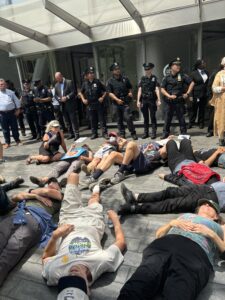
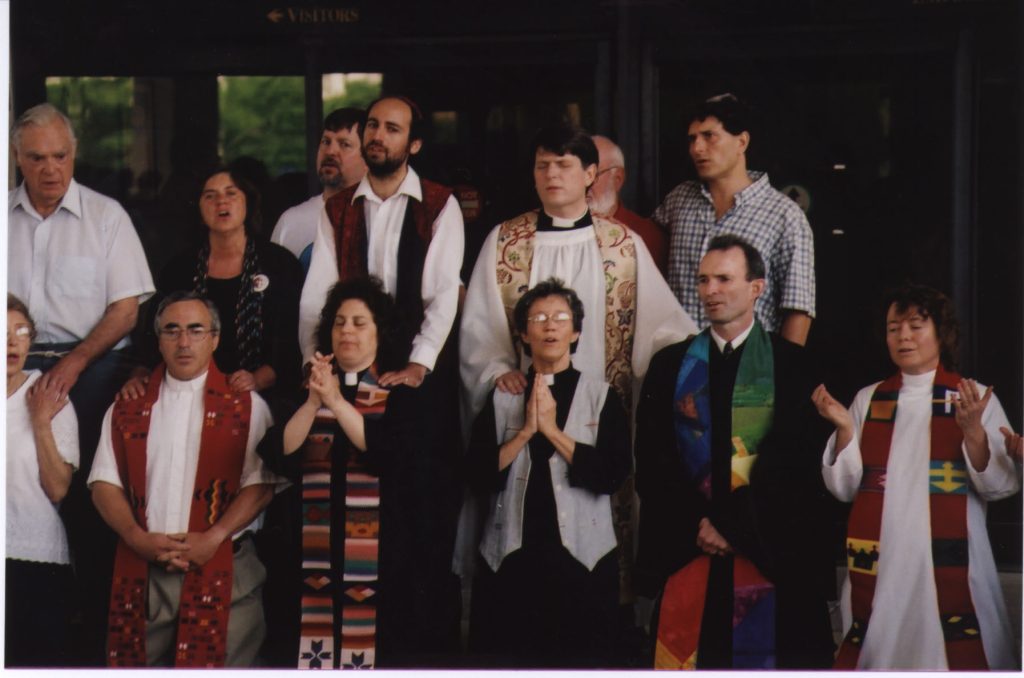
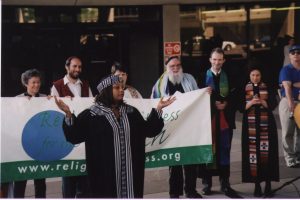
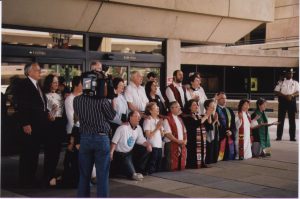
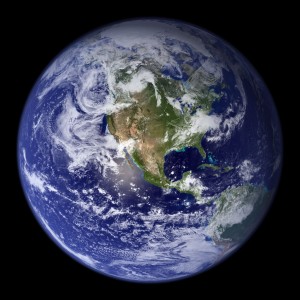
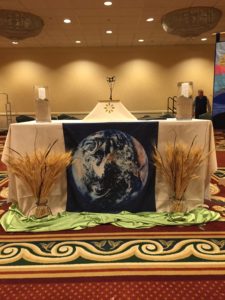
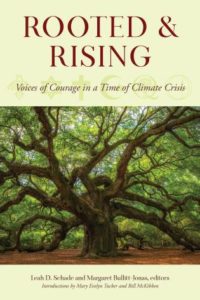
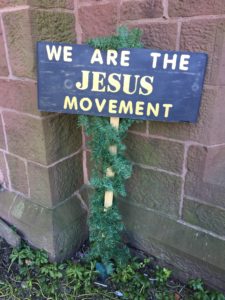
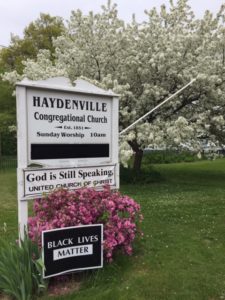 These are urgent and tender words, the words of someone facing death and eager to convey what really matters. “Little children, love one another.” I’m told that in John the Evangelist’s old age, that was the basic message he brought to one community of faith after another: “Little children, love one another.” After spending time with Jesus, and after years of meditating on Jesus’ life and teaching, on Jesus’ crucifixion and resurrection, the aging evangelist could find no more direct route into the heart of the Gospel than simply to say, “Little children, love one another.”
This brings to mind a poem by Michael Leunig:1
There are only two feelings. Love and fear.
There are only two languages. Love and fear.
There are only two activities. Love and fear.
There are only two motives, two procedures,
two frameworks, two results.
Love and fear.
Love and fear.
As followers of Jesus, we may be called to love, but I don’t for a moment believe that we’re not also well acquainted with fear. I remember my childhood fears, such as my fear of the monsters lurking under the bed, and how important it was not to let even one toe stick out beyond the edge of the mattress. I remember my fear that when my parents went out at night, they might not come back. I remember my fear of the swarm of bees that nested near the front door; my fear, during piano recitals, that I might forget which note came next; my fear that I might be chosen last for the softball team, or, what’s worse, that the ball might actually come hurtling in my direction and – dreadful thought – all my team-mates would count on me to catch it.
The fears of a child gradually morph into the fears of an adult, and even though we grownups may go to a great deal of trouble not to appear anxious or afraid, most us face some kind of fear every day. Fears come in all shapes and sizes. What are you afraid of? Chances are excellent that several of us fear the same thing. And we know what that’s like: how, when frightened, we hold our breath, our bellies clench and our hearts race.
There’s a lot of fear going around these days, and we have reason to worry. In addition to our personal fears, we feel a collective shudder about the state of the world, from the assault on women’s reproductive rights to the harsh treatment of immigrants. For me, it’s the ecological crisis that wakes me up at night, for scientists are reporting with increasing concern that the web of life is unraveling before our eyes and that human civilization is at risk of collapse. Just think of it: the number of animals around the world has plummeted by over half in less than 50 years, mostly by the development of great swaths of land and the destruction of habitat.
These are urgent and tender words, the words of someone facing death and eager to convey what really matters. “Little children, love one another.” I’m told that in John the Evangelist’s old age, that was the basic message he brought to one community of faith after another: “Little children, love one another.” After spending time with Jesus, and after years of meditating on Jesus’ life and teaching, on Jesus’ crucifixion and resurrection, the aging evangelist could find no more direct route into the heart of the Gospel than simply to say, “Little children, love one another.”
This brings to mind a poem by Michael Leunig:1
There are only two feelings. Love and fear.
There are only two languages. Love and fear.
There are only two activities. Love and fear.
There are only two motives, two procedures,
two frameworks, two results.
Love and fear.
Love and fear.
As followers of Jesus, we may be called to love, but I don’t for a moment believe that we’re not also well acquainted with fear. I remember my childhood fears, such as my fear of the monsters lurking under the bed, and how important it was not to let even one toe stick out beyond the edge of the mattress. I remember my fear that when my parents went out at night, they might not come back. I remember my fear of the swarm of bees that nested near the front door; my fear, during piano recitals, that I might forget which note came next; my fear that I might be chosen last for the softball team, or, what’s worse, that the ball might actually come hurtling in my direction and – dreadful thought – all my team-mates would count on me to catch it.
The fears of a child gradually morph into the fears of an adult, and even though we grownups may go to a great deal of trouble not to appear anxious or afraid, most us face some kind of fear every day. Fears come in all shapes and sizes. What are you afraid of? Chances are excellent that several of us fear the same thing. And we know what that’s like: how, when frightened, we hold our breath, our bellies clench and our hearts race.
There’s a lot of fear going around these days, and we have reason to worry. In addition to our personal fears, we feel a collective shudder about the state of the world, from the assault on women’s reproductive rights to the harsh treatment of immigrants. For me, it’s the ecological crisis that wakes me up at night, for scientists are reporting with increasing concern that the web of life is unraveling before our eyes and that human civilization is at risk of collapse. Just think of it: the number of animals around the world has plummeted by over half in less than 50 years, mostly by the development of great swaths of land and the destruction of habitat. 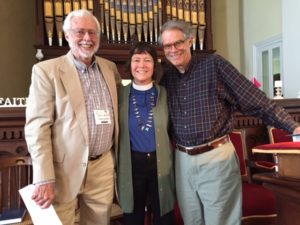
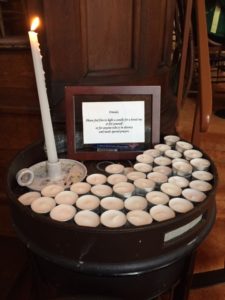 I will end with a story about love and fear.4 Back in 2001 I screwed up my courage and decided to carry out my first act of civil disobedience. That’s how I met your former pastor, Andrea Ayvazian: in Washington, DC, where she was helping to organize a new interfaith group, Religious Witness for the Earth, that was planning to protest President Bush’s intention to drill for more oil in the Arctic.
Here’s what happened: On the first day we learned about oil drilling and the Arctic, about climate change and fossil fuels. On the second we lobbied our members of Congress and studied the disciplines of non-violent civil disobedience. On the third, about a hundred of us marched down Independence Avenue in religious vestments, carrying banners and singing. When we reached the Department of Energy, an enormous stone structure surrounded by police, we held a brief worship service. So far, everything was legal. Then came the part that wasn’t. I’ll read from an essay I wrote about what that was like.
The worship service was coming to an end. We sang “Amazing Grace,” and then the twenty-two of us who had decided to risk arrest joined hands and walked slowly to the doors of the Department of Energy.
I felt us cross an invisible boundary. With the others, I stepped over a threshold I could not see. I walked out of my ordinary life.
I am neither a law-breaker nor a thrill-seeker. More often than not, I follow the rules – even enforce them. I fasten my seat belt, don’t cheat on taxes, write thank you notes, and stand up when the band plays our national anthem. But here I was, intentionally and publicly breaking the law. As if some inner revolution had quietly taken place, the old “me” was no longer in charge. Whatever security I’d felt in operating within the rules was gone. That’s partly why I felt so frightened as I left the safety of the circle and moved toward the door: I hardly recognized myself. I hardly knew who I was.
§§
We stand or kneel in prayer, our backs to the building.
The pavement under my knees is hard. At home, I often sit on a meditation cushion to pray. Today there is no cushion, just the weight of my body against stone. I lift up my hands. I’m dressed for Holy Communion. I might as well hold out my arms as I do at Communion.
Instead of pews filled with parishioners, I see ranks of police and a cluster of supporters. I am afraid. I’ve never been arrested before. Years ago, as a VISTA volunteer in Mayor Rizzo’s Philadelphia I heard countless stories of police brutality. It’s not that I really expect the same thing to happen to me – the punch in the gut, the assault behind closed doors. Still, my body tenses as I place myself against the cops, the Feds, the law.
I close my eyes. One by one we pray aloud, words thrown into space, words hurled against stone.
Is this whole thing ridiculous? I briefly open my eyes and notice a well-dressed man watching us. He strokes his tie, leans over and says something to a fellow nearby. The two of them chuckle. I have no idea what they’re talking about but I wonder if they think we look absurd. I suppose we do. Here we are with our jerry-rigged signs, our predictably earnest songs and prayers of protest, a foolhardy band straight out of the ‘60’s.
Defensively, I imagine confronting that mocking man with the arsenal of our credentials. “We’re no rag-tag bunch,” I want to tell him. “We’re people with doctorates and master’s degrees – nurses and ministers, writers and accountants. Thoughtful people, educated people, professionals.”
I am distracted from prayer by this indignant outburst. “Let it go,” wisdom tells me. “None of that matters — your degrees, your skills, your status in the world. The privileges of race and class mean nothing now. You’re a woman on your knees, that’s who you are — one human being pleading with God.”
I turn my attention back to prayer and continue to stretch out my arms. Suddenly I realize that behind the tension, behind the fear and self-consciousness, something else is welling up. I am jubilant.
“Lift up your hearts,” I might as well be saying to the people before me, beaming as broadly as I do at Communion.
“We lift them to the Lord,” would come the response.
How did I miss it? After years of going to church, after years of celebrating Communion, only now, as I kneel on pavement and face a phalanx of cops, do I understand so clearly that praising God can be an act of political resistance. That worship is an act of human liberation. The twenty-two of us come from different faith traditions, but each of us is rooted in a reality that transcends the rules and structures of this world. Tap into that transcendent truth, let the divine longing for a community of justice and mercy become your own deepest longing, and who knows what energy for life will be released?
I feel as defiant as a maple seedling that pushes up through asphalt. It is God I love, and God’s green earth. I want to bear witness to that love even in the face of hatred or indifference, even if the cost is great.
So what if our numbers are small? So what if, in the eyes of the police, in the eyes of the world, we have no power? I’m beginning to sense the power that is ours to wield, the power of self-offering. We may have nothing else, but we do have this, the power to say, “This is where I stand. This is what I love. Here is something for which I’m willing to put my body on the line.”
I never knew that stepping beyond the borders of what I find comfortable could make me so happy. That shifting from self-preservation to self-offering could awaken so much joy.
Love and fear. Love and fear. I invite you to take a moment to remember a time when you took a brave step toward fullness of life, a time when you made a decision to do the right thing, even though you knew it would be difficult or costly. Who inspired you to be bolder than you thought? With whom do you hold hands, literally or figuratively, when you step out to make a difference in the world? And if you knew you could not fail – if you were set free from fear – what would you do for the healing of our world?
Let’s take a moment in silence, and then I invite your response.
1. Michael Leunig, A Common Prayer (NY: HarperCollins, 1991).
2. David Wallace-Wells, The Uninhabitable Earth (New York: Tim Duggan Books, Penguin Random House, 2019).
3. Hafiz, quoted by Jack Kornfield, The Art of Forgiveness, Lovingkindness, and Peace (New York: Bantam Books, 2002), 83.
4. This story is adapted from part of my chapter, “When Heaven Happens,” in the anthology Heaven, ed. Roger Ferlo (New York: Seabury Books, 2007), 78-81.
I will end with a story about love and fear.4 Back in 2001 I screwed up my courage and decided to carry out my first act of civil disobedience. That’s how I met your former pastor, Andrea Ayvazian: in Washington, DC, where she was helping to organize a new interfaith group, Religious Witness for the Earth, that was planning to protest President Bush’s intention to drill for more oil in the Arctic.
Here’s what happened: On the first day we learned about oil drilling and the Arctic, about climate change and fossil fuels. On the second we lobbied our members of Congress and studied the disciplines of non-violent civil disobedience. On the third, about a hundred of us marched down Independence Avenue in religious vestments, carrying banners and singing. When we reached the Department of Energy, an enormous stone structure surrounded by police, we held a brief worship service. So far, everything was legal. Then came the part that wasn’t. I’ll read from an essay I wrote about what that was like.
The worship service was coming to an end. We sang “Amazing Grace,” and then the twenty-two of us who had decided to risk arrest joined hands and walked slowly to the doors of the Department of Energy.
I felt us cross an invisible boundary. With the others, I stepped over a threshold I could not see. I walked out of my ordinary life.
I am neither a law-breaker nor a thrill-seeker. More often than not, I follow the rules – even enforce them. I fasten my seat belt, don’t cheat on taxes, write thank you notes, and stand up when the band plays our national anthem. But here I was, intentionally and publicly breaking the law. As if some inner revolution had quietly taken place, the old “me” was no longer in charge. Whatever security I’d felt in operating within the rules was gone. That’s partly why I felt so frightened as I left the safety of the circle and moved toward the door: I hardly recognized myself. I hardly knew who I was.
§§
We stand or kneel in prayer, our backs to the building.
The pavement under my knees is hard. At home, I often sit on a meditation cushion to pray. Today there is no cushion, just the weight of my body against stone. I lift up my hands. I’m dressed for Holy Communion. I might as well hold out my arms as I do at Communion.
Instead of pews filled with parishioners, I see ranks of police and a cluster of supporters. I am afraid. I’ve never been arrested before. Years ago, as a VISTA volunteer in Mayor Rizzo’s Philadelphia I heard countless stories of police brutality. It’s not that I really expect the same thing to happen to me – the punch in the gut, the assault behind closed doors. Still, my body tenses as I place myself against the cops, the Feds, the law.
I close my eyes. One by one we pray aloud, words thrown into space, words hurled against stone.
Is this whole thing ridiculous? I briefly open my eyes and notice a well-dressed man watching us. He strokes his tie, leans over and says something to a fellow nearby. The two of them chuckle. I have no idea what they’re talking about but I wonder if they think we look absurd. I suppose we do. Here we are with our jerry-rigged signs, our predictably earnest songs and prayers of protest, a foolhardy band straight out of the ‘60’s.
Defensively, I imagine confronting that mocking man with the arsenal of our credentials. “We’re no rag-tag bunch,” I want to tell him. “We’re people with doctorates and master’s degrees – nurses and ministers, writers and accountants. Thoughtful people, educated people, professionals.”
I am distracted from prayer by this indignant outburst. “Let it go,” wisdom tells me. “None of that matters — your degrees, your skills, your status in the world. The privileges of race and class mean nothing now. You’re a woman on your knees, that’s who you are — one human being pleading with God.”
I turn my attention back to prayer and continue to stretch out my arms. Suddenly I realize that behind the tension, behind the fear and self-consciousness, something else is welling up. I am jubilant.
“Lift up your hearts,” I might as well be saying to the people before me, beaming as broadly as I do at Communion.
“We lift them to the Lord,” would come the response.
How did I miss it? After years of going to church, after years of celebrating Communion, only now, as I kneel on pavement and face a phalanx of cops, do I understand so clearly that praising God can be an act of political resistance. That worship is an act of human liberation. The twenty-two of us come from different faith traditions, but each of us is rooted in a reality that transcends the rules and structures of this world. Tap into that transcendent truth, let the divine longing for a community of justice and mercy become your own deepest longing, and who knows what energy for life will be released?
I feel as defiant as a maple seedling that pushes up through asphalt. It is God I love, and God’s green earth. I want to bear witness to that love even in the face of hatred or indifference, even if the cost is great.
So what if our numbers are small? So what if, in the eyes of the police, in the eyes of the world, we have no power? I’m beginning to sense the power that is ours to wield, the power of self-offering. We may have nothing else, but we do have this, the power to say, “This is where I stand. This is what I love. Here is something for which I’m willing to put my body on the line.”
I never knew that stepping beyond the borders of what I find comfortable could make me so happy. That shifting from self-preservation to self-offering could awaken so much joy.
Love and fear. Love and fear. I invite you to take a moment to remember a time when you took a brave step toward fullness of life, a time when you made a decision to do the right thing, even though you knew it would be difficult or costly. Who inspired you to be bolder than you thought? With whom do you hold hands, literally or figuratively, when you step out to make a difference in the world? And if you knew you could not fail – if you were set free from fear – what would you do for the healing of our world?
Let’s take a moment in silence, and then I invite your response.
1. Michael Leunig, A Common Prayer (NY: HarperCollins, 1991).
2. David Wallace-Wells, The Uninhabitable Earth (New York: Tim Duggan Books, Penguin Random House, 2019).
3. Hafiz, quoted by Jack Kornfield, The Art of Forgiveness, Lovingkindness, and Peace (New York: Bantam Books, 2002), 83.
4. This story is adapted from part of my chapter, “When Heaven Happens,” in the anthology Heaven, ed. Roger Ferlo (New York: Seabury Books, 2007), 78-81. 